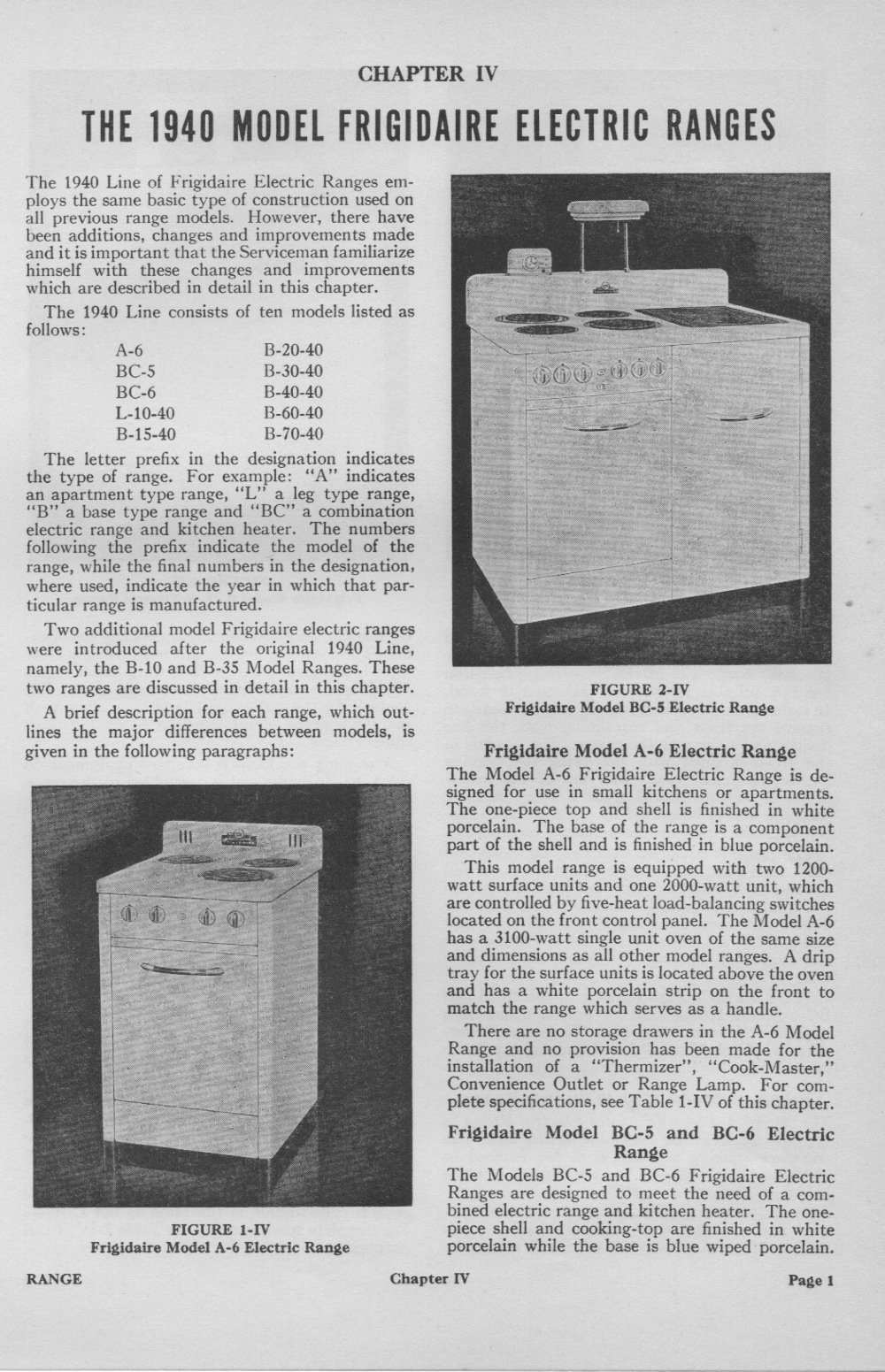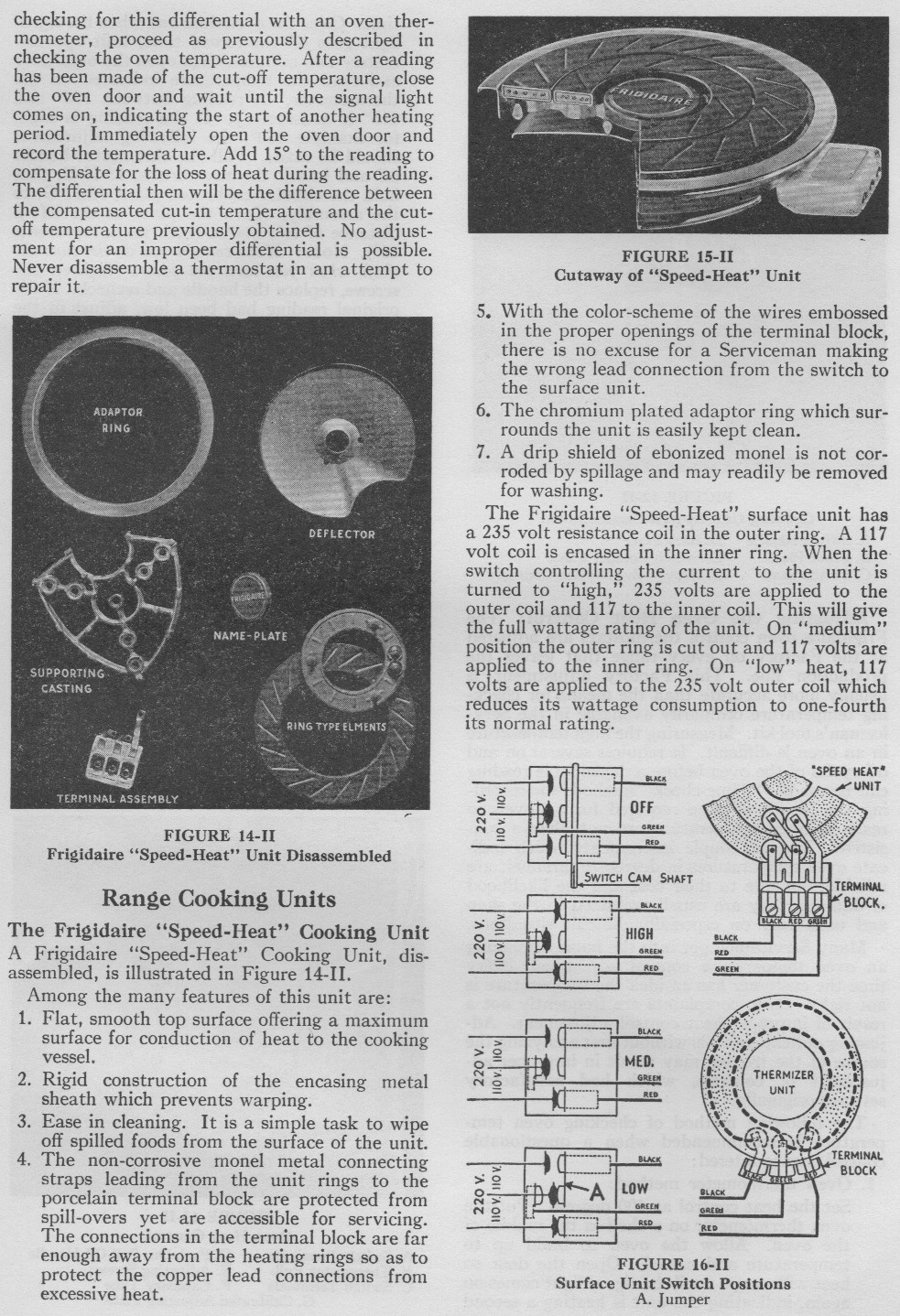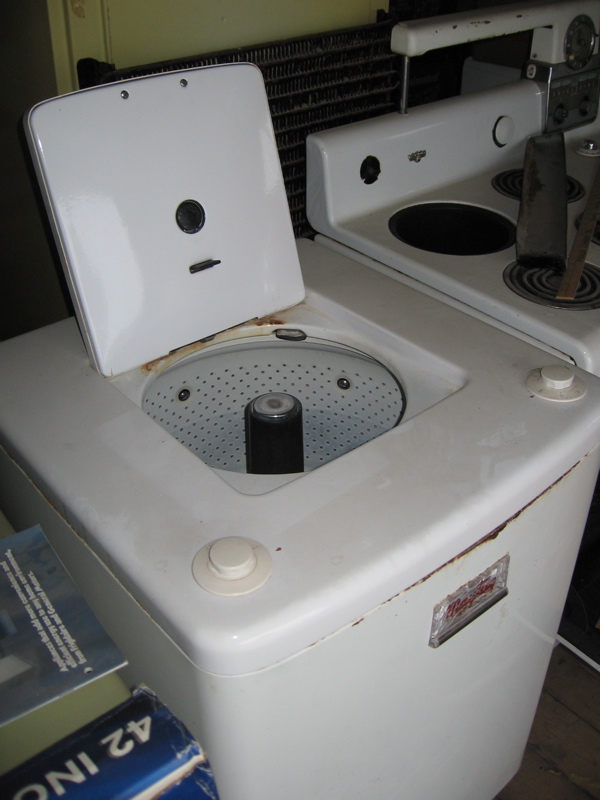|
Thread Number: 38540
Frgidaire 1940 Electric Range line-up |
[Down to Last] |
Post# 571760 1/27/2012 at 14:11 (4,482 days old) by kenmore71  (Minneapolis, MN) (Minneapolis, MN) |
||

Here are 7 pages from the service manual describing the 1940 line of Frigidaire electric ranges.
The most interesting feature for me is that this seems to be the first year that Frigidaire entered into the market of producing an electric range with a wood or coal-fired kitchen heater all in one cabinet. 
| ||

|
Post# 571762 , Reply# 1 1/27/2012 at 14:12 (4,482 days old) by kenmore71  (Minneapolis, MN) (Minneapolis, MN) |
||
 | ||
Post# 571764 , Reply# 2 1/27/2012 at 14:14 (4,482 days old) by kenmore71  (Minneapolis, MN) (Minneapolis, MN) |
||
 | ||
Post# 571765 , Reply# 3 1/27/2012 at 14:15 (4,482 days old) by kenmore71  (Minneapolis, MN) (Minneapolis, MN) |
||
 | ||
Post# 571767 , Reply# 4 1/27/2012 at 14:15 (4,482 days old) by kenmore71  (Minneapolis, MN) (Minneapolis, MN) |
||
 | ||
Post# 571769 , Reply# 5 1/27/2012 at 14:16 (4,482 days old) by kenmore71  (Minneapolis, MN) (Minneapolis, MN) |
||
 | ||
Post# 571770 , Reply# 6 1/27/2012 at 14:17 (4,482 days old) by kenmore71  (Minneapolis, MN) (Minneapolis, MN) |
||
 | ||
Post# 571772 , Reply# 7 1/27/2012 at 14:20 (4,482 days old) by kenmore71  (Minneapolis, MN) (Minneapolis, MN) |
||
 | ||
Post# 571774 , Reply# 8 1/27/2012 at 14:22 (4,482 days old) by kenmore71  (Minneapolis, MN) (Minneapolis, MN) |
||
 | ||
Post# 571904 , Reply# 9 1/28/2012 at 00:47 (4,481 days old) by Tomturbomatic  (Beltsville, MD) (Beltsville, MD) |
||
|
Thank you for these pages! Can anyone tell me what size pieces of coal would be used in this heater? I guess it would not be pea coal, but not the sizes shoveled into a furnace either. Thank you. | ||
Post# 571907 , Reply# 10 1/28/2012 at 00:57 (4,481 days old) by Tomturbomatic  (Beltsville, MD) (Beltsville, MD) |
||
|
I have never burned coal nor started a coal fire. This article was informative and scary. CLICK HERE TO GO TO Tomturbomatic's LINK | ||
Post# 571946 , Reply# 11 1/28/2012 at 08:15 (4,481 days old) by polkanut  (Wausau, WI ) (Wausau, WI ) |
||
 | ||
| Post# 571966 , Reply# 12 1/28/2012 at 10:12 (4,481 days old) by westie2 () | ||
|
Mark/Kenmore71
Thanks for the scans. To me those stoves sure had the bells and whistlers on them They look as good as anything today and I am sure they cooked better.
| ||
Post# 571991 , Reply# 14 1/28/2012 at 14:24 (4,481 days old) by kenmore71  (Minneapolis, MN) (Minneapolis, MN) |
||

Actually, the 1937-38 models had three heats for all the heating elements.
In 1939 they introduced the 5-heat switch for all of the surface elements EXCEPT the Thermizer element which retained a 3-heat switch. Maybe later today I will get a chance to scan the 1941 models which was when Frigidaire introduced the first of its 3 incarnations of the "Radiantube" surface cooking heating elements. This element was thicker in width than the GE Calrod element but was not as thick as the later 3-wire (and eventually only 2-wire with the introduction of the "infinite heat controls in the late 50s) elements that were used by Frigidaire throughout the 1950s. In terms of thickness, this first Radiantube style looks rather like the Westinghouse "Corox" elements. I would imagine that cooking on these early models with the flat disc elements was a bit of a trial and definitely took some getting used to. However, when you stop to consider that most likely the largest markets for these ranges were farmsteads and small towns that were benefitting from Rural Electrification and that most of these homes had no natural gas service and were switching from cooking with wood or kerosene to electric that the trials and limitations of these ranges paled in comparison to the advantages that they brought. I know for a fact that my maternal grandparents abandoned their wood cookstove and installed an electric range the MINUTE that electricity came to the farm in 1939. Since farms were provided with relatively heavy wiring from the start (typically 60 amps of 115/230 volt single phase) for the anticipated use of milking machines, water pumps, milk coolers, etc., the load demands of an electric range were well within those parameters. There is also a fascinating picture somewhere in the family "archives" of my grandmother's 1950 or so GE electric dryer situated right up against the range in the kitchen. I once asked her about that picture and she said they put it there because that's where the heavy outlet was. She also noted that it was not possible to bake and run the dryer at the same time without melting the fuses. This post was last edited 01/28/2012 at 15:52 | ||
Post# 571995 , Reply# 15 1/28/2012 at 14:47 (4,480 days old) by wayupnorth  (On a lake between Bangor and Bar Harbor, Maine) (On a lake between Bangor and Bar Harbor, Maine) |
||
Coal Fires
Actually a coal fire is much easier than you think to start and especially maintain. In Tomturbomatic's article they pretty much covered it. I had an ancient 200 year old house once with a coal stove to suppliment the oil furnace. Using the charcoal or wood pellets were definitely the easiest in getting it going for the first time but if you just shook it down and added more coal twice a day, it would continue to throw off good heat until the outside temperature did go to 50 or so and the fire would just smother itself and go out. Before oil furnaces were popular around here, people had dual purpose heaters and furnaces in their basements (we called them octopusses). You had to burn only wood until the ambient outside temperature was cold enough and then switched to coal for the remainder of the winter. Ther was always a corner of the basement near a window that was the designated coal bin for bulk delivery.
| ||
Post# 572022 , Reply# 17 1/28/2012 at 18:31 (4,480 days old) by kenmore71  (Minneapolis, MN) (Minneapolis, MN) |
||

Here is scan of the service manual showing the design and explaining the operation of the first generation "speed heat" surface units that were used from 1937-1940.
It is certainly an interesting side note that Frigidaire would later re-use the term "speed-heat" in the late 1950s when they introduced the 120 volt 2 wire surface unit combined with the "speed heat" switch that would flash that unit with 240 volts when first turned on to bring it up to temperature very quickly! 
| ||
Post# 572023 , Reply# 18 1/28/2012 at 18:32 (4,480 days old) by Launderess  (Quiet Please, There´s a Lady on Stage) (Quiet Please, There´s a Lady on Stage) |
||
Coal For Heating Is Making A Comback
Though limited in some areas of the Northeast with abundant supplies such as PA, Maine, etc...
With propane gas and oil prices going through the roof many with homes that still have the old furnaces/boilers that can burn coal will do so. Problem is finding a steady supply source. The "coal man" isn't exactly the staple of American life he once was, nor are coal burning steam locomotives. By the latter one means according to stories told by "old timers" it was common for those whom couldn't afford to purchase coal to hang around RR tracks and other infrastructure to gather up bits of the stuff that fell off train's coal cars and or was otherwise littered about. Usually this was done by children and as one can imagine was quite dangerous both because of the risk of being struck by a locomotive but also from RR police who took a dim view of "stealing". | ||
Post# 572024 , Reply# 19 1/28/2012 at 18:32 (4,480 days old) by kenmore71  (Minneapolis, MN) (Minneapolis, MN) |
||
 | ||
Post# 572025 , Reply# 20 1/28/2012 at 18:36 (4,480 days old) by kenmore71  (Minneapolis, MN) (Minneapolis, MN) |
||
 | ||
Post# 572026 , Reply# 21 1/28/2012 at 18:38 (4,480 days old) by Launderess  (Quiet Please, There´s a Lady on Stage) (Quiet Please, There´s a Lady on Stage) |
||
Keeping Coal Fired Ranges/Boilers Going
Remember watching "1900 House" and the troubles the poor family (especially the mother) had keeping the range going much less getting it to heat water for the boiler.
Apparently no one bothered to teach the mother in depth how to start, bank and maintain a coal fired range. This was something Victorian/Edwardian girls would have learned quite early in life as part of helping with household chores. The woman did eventually learn but the huge amount of time it took out of her day (stoking, shaking down grates,etc...). As for heating hot water, it turns out the contractors who installed the range out of modern safety concerns moved it very far from the heat exchanger, thus the thing wouldn't power the boiler properly. Once the thing was moved into the proper position things were fine. Ok, hijack over... | ||
Post# 572029 , Reply# 23 1/28/2012 at 18:41 (4,480 days old) by kenmore71  (Minneapolis, MN) (Minneapolis, MN) |
||
 | ||
Post# 572030 , Reply# 24 1/28/2012 at 18:44 (4,480 days old) by kenmore71  (Minneapolis, MN) (Minneapolis, MN) |
||
 | ||
Post# 572031 , Reply# 25 1/28/2012 at 18:45 (4,480 days old) by kenmore71  (Minneapolis, MN) (Minneapolis, MN) |
||
 | ||
Post# 572032 , Reply# 26 1/28/2012 at 18:47 (4,480 days old) by kenmore71  (Minneapolis, MN) (Minneapolis, MN) |
||
 | ||
Post# 572033 , Reply# 27 1/28/2012 at 18:49 (4,480 days old) by kenmore71  (Minneapolis, MN) (Minneapolis, MN) |
||
 | ||
Post# 572035 , Reply# 28 1/28/2012 at 19:12 (4,480 days old) by wayupnorth  (On a lake between Bangor and Bar Harbor, Maine) (On a lake between Bangor and Bar Harbor, Maine) |
||

You are both right Tomturbomatic and Laundress regarding coal burning. Coal is still available here, mostly in 50 lb. bags or by bulk but it is screened, washed and oil treated, so there is no black dust, and not that cheap. Anthricite is the preferred coal as Bituminous is stinky and smoky. I am guessing the smoke/gas is nowhere as warm as wood, thats why it will not go up the chimney unless its cold outside. My coal stove's smoke pipe was always cool to the touch, all the heat radiated from the bottom so there was no danger of a chimney fire. Most of the old gravity furnaces were either one big outlet or several smaller ducts coming from the top of huge thing that looked like a gigantic tin can going to all directions in the house, thus the octopus. Many people did replace the coal grates with an oil or gas burner, but it was terribly inefficient. The new thing around here is a pellet stove. There are several factories that take the wood waste from sawmills and compress them into small pellets, think rabbit food, only bigger. These stoves are direct vented thru a wall, produce a ton of heat, are very efficient and the pellets are cheap. But they require electricity, so no power, no heat. Before my grandfather retired from the railroad, he bought a couple of the caboose pot bellied coal stoves (I have one in storage) before they swapped to kerosene. So I always will have another option. The only electric with a side heater I ever remembered seeing was my aunts Magee. I never had a clue Frigidaire ever made them.
| ||
Post# 572116 , Reply# 30 1/29/2012 at 10:03 (4,480 days old) by steved  (Guilderland, New York) (Guilderland, New York) |
||
|
picking up coal from the street I remember my dad telling the story of how, during the depression, they threw rocks at the locomotives that passed their house in hopes that the engineer would retaliate and throw coal back at them. Then they gathered it to bring home for the stove. | ||
Post# 572364 , Reply# 33 1/30/2012 at 10:06 (4,479 days old) by swestoyz  (Cedar Falls, IA) (Cedar Falls, IA) |
||

While not a pre-war range in terms of when it was produced, I did run across a 1946/1947 GM range years ago - based on the 1940/1941 range. This is the only time I recall seeing the early style GM burners. Unfortunately this range (and the rest of the appliances in the thread) was crushed back before the flood of '08.
Ben CLICK HERE TO GO TO swestoyz's LINK 
| ||
Post# 572390 , Reply# 34 1/30/2012 at 12:03 (4,479 days old) by kenmore71  (Minneapolis, MN) (Minneapolis, MN) |
||

Ben, that is what I expected in terms of surface unit design. Most auto and appliance manufacturers resumed domestic production in late 1945 with basically the 1942 models. In my observations it wasn't until about the 1947-48 design year that radically "new" things were being produced. There simply wasn't the man-power or the capital to re-design and re-tool production immediately after the war. I'm guessing that the 3-wire wide/flat topped Radiantube made its debut in either 1949 or 1950.
| ||
Post# 576832 , Reply# 36 2/18/2012 at 17:29 (4,459 days old) by Kenmore71  (Minneapolis, MN) (Minneapolis, MN) |
||

Posting here is a very good first step.
Anyone out there who might have one of these ranges or some parts lying around might well be interested in helping out out. That is definitely a 1940s model. I'm not at home right now so I can't look up the actual model number and year. That original style "radiantube" surface element was introduced in 1941 and phased out for the wide, flat 3-wire radiantube in 1949. Hopefully I'll remember to look it up later this weekend. Does the "well" (known as the "Thermizer") have the "Thrifto-matic" switch where the "High" heat setting is available only on a spring-wound timer portion of the control dial? I think this feature is so cool. For those of you out there who want to know what this did: The Deep-well cooker was in some ways the precurser of the "Crock pot" and allowed you to cook partial or whole meals at low temperatures in a semi-insulated aluminum pot. The heat control had 4 (the early had only 3) heat settings and they were arranged in this order on the dial: OFF, MED HIGH, MED LOW, SIMMER, & HIGH. HIGH, however, was not a notched stop but instead a 30-minute spring-wound timer. You would set the timer for how long you wanted the "Thermizer" to heat on HIGH and then it would automatically go to SIMMER. Considering that these were low wattage elements to begin with (600 watts originaly, later increased to 635, and still later to around 1000 watts in the 50s) the SIMMER setting was around 125-150 watts which is about the same as LOW on a crock pot! | ||
Post# 576918 , Reply# 37 2/19/2012 at 00:36 (4,459 days old) by Kenmore71  (Minneapolis, MN) (Minneapolis, MN) |
||

Do you by any chance happen to have the exact model number of that range?
The last 2 numbers of the model would indicate the year of production. I don't have specific info on the 1946-1950 ranges in my possession, but if I had to guess, I would say that your is a 1947 or 1948 model. I have detailed information on the 1942 models and when production resumed in late 1945, they basically produced one (or maybe two) of the 1942 models until they came out with the whole new line of "1947" models. | ||

 Comes to the Rescue!
Comes to the Rescue!